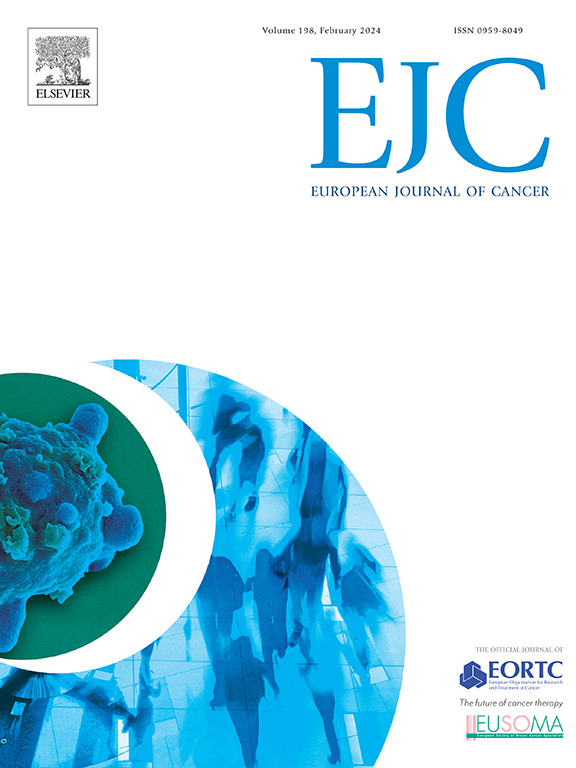增加脑脊液循环肿瘤细胞数量对上皮性肿瘤轻脑膜转移患者的预后价值
IF 7.6
1区 医学
Q1 ONCOLOGY
引用次数: 0
摘要
背景:来自实体瘤的脑脊膜转移(LM)在高达10% %的患者中被描述,中位生存率很低。脑脊液循环肿瘤细胞计数的先进技术可以帮助诊断LM患者,但也可能对预后有价值。我们的目的是研究脑脊液中循环肿瘤细胞(CTCs)的数量是否对LM患者的生存预测有附加价值。方法:我们在一组连续的上皮性肿瘤LM患者中进行了一项单中心回顾性研究。采用基于上皮细胞黏附分子(Epithelial Cell Adhesion Molecule, EpCAM)的免疫流式细胞术检测脑脊液循环肿瘤细胞,用于LM诊断。评估脑脊液中ctc数量在LM已知临床预后因素之上的附加预后价值。我们通过判别性能指标比较了有和没有ctc的Cox比例风险回归模型。结果我们纳入了103例符合条件的上皮性肿瘤患者(60% % NSCLC, 29 %乳腺癌),根据EANO-ESMO标准诊断为可能、可能或确诊的LM。中位生存期为129天。在多变量预后模型中,脑脊液中CTC数具有显著的附加预后价值(HR = 1.86, 95 % CI = 1.26-2.76,似然比检验p值=0.003)。结论我们的研究结果表明,EpCAM免疫流式细胞术测量的脑脊液中ctc的数量,与其他已知的LM临床生存预测指标相比,具有额外的预后价值。在评估LM患者的预后时,应考虑CSF中ctc的数量。本文章由计算机程序翻译,如有差异,请以英文原文为准。
Added prognostic value of circulating tumor cell numbers in CSF of patients with leptomeningeal metastasis from epithelial tumors
Background
Leptomeningeal metastases (LM) from solid tumors are described in up to 10 % of patients, and median survival rates are low. Advanced techniques for circulating tumor cell enumeration in cerebrospinal fluid (CSF) can help in diagnosing patients with LM but also could have value in prognostication. Our aim was to investigate whether the number of circulating tumor cells (CTCs) in CSF are of added value in survival prediction in LM patients.
Methods
We performed a single-center retrospective study in a cohort of consecutive patients with LM from epithelial tumors. Circulating tumor cells in CSF were measured by an Epithelial Cell Adhesion Molecule (EpCAM)-based immunoflow cytometry method at LM diagnosing. The added prognostic value of the number of CTCs in CSF on top of known clinical prognostic factors for LM was assessed. We compared Cox proportional hazards regression models with and without CTCs by discriminative performance measures.
Results
We included 103 eligible patients with epithelial tumors (60 % NSCLC, 29 % breast cancer), who were diagnosed with either possible, probable, or confirmed LM according to EANO-ESMO criteria. Median survival was 129 days. CTC numbers in CSF were of significant added prognostic value in a multivariable prognostic model (HR = 1.86, 95 % CI = 1.26–2.76, likelihood ratio test p-value=0.003 for models with CTCs versus without CTCs).
Conclusion
Our findings indicate that the number of CTCs in CSF, as measured by EpCAM immunoflow cytometry, are of additional prognostic value to other well-known clinical predictors of survival in LM. The number of CTCs in CSF should be taken in account when assessing the prognosis of patients with LM.
求助全文
通过发布文献求助,成功后即可免费获取论文全文。
去求助
来源期刊

European Journal of Cancer
医学-肿瘤学
CiteScore
11.50
自引率
4.80%
发文量
953
审稿时长
23 days
期刊介绍:
The European Journal of Cancer (EJC) serves as a comprehensive platform integrating preclinical, digital, translational, and clinical research across the spectrum of cancer. From epidemiology, carcinogenesis, and biology to groundbreaking innovations in cancer treatment and patient care, the journal covers a wide array of topics. We publish original research, reviews, previews, editorial comments, and correspondence, fostering dialogue and advancement in the fight against cancer. Join us in our mission to drive progress and improve outcomes in cancer research and patient care.
 求助内容:
求助内容: 应助结果提醒方式:
应助结果提醒方式:


